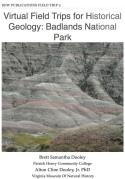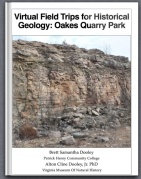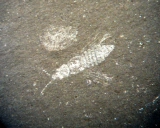 I’ve finally returned home from the GSA conference, with a diversion along the way to collect Ordovician fossils. But on our drive out to the conference, we detoured to Baraboo, Wisconsin so Tim could work on a geology field lab. As you approach Baraboo from the south, after a day of driving across the Great Plains, a feature tends to jump out at you: a series of long, wooded hills (above), that suggest that something geologically interesting has happened.
I’ve finally returned home from the GSA conference, with a diversion along the way to collect Ordovician fossils. But on our drive out to the conference, we detoured to Baraboo, Wisconsin so Tim could work on a geology field lab. As you approach Baraboo from the south, after a day of driving across the Great Plains, a feature tends to jump out at you: a series of long, wooded hills (above), that suggest that something geologically interesting has happened.
For our field trip, we covered 10 stops in 2 days, as shown on the Google Earth image below (Stop 2 is very close to Stop 3, so they can’t easily be distinguished at this scale):
Because there are several localities, and a relatively complex story to tell, I’m going to divide this into several posts. At first I’m going to just describe what we saw, saving the interpretation for the last post in the series.
Stops 1-3 are all located on the trail to Parfrey’s Glen, a small canyon that cuts through these hills. Stop 1 was a stream cut, with pinkish rocks that appear to be tilted to the northwest (they’re dipping more or less from left to right in this image):
A closer look at the rocks showed that they’re made mostly of quartz, suggesting that they’re quartzite, a metamorphosed sandstone.
Further along the trail at Stop 2, and about 30 m higher in elevation, we find a different type of rock:
 These rocks are pretty much flat-lying (not tilted). A few meters further, at Stop 3, we can see them up close:
These rocks are pretty much flat-lying (not tilted). A few meters further, at Stop 3, we can see them up close:
 Looking past all the lichens and liverworts, these rocks are coarse-grained sandstones and conglomerates, sedimentary rocks that formed in a pretty high-energy environment. Some of the cobbles in the conglomerate beds are quite large, and even more interesting, they appear to largely be made of the same pink quartzite we saw further down the trail.
Looking past all the lichens and liverworts, these rocks are coarse-grained sandstones and conglomerates, sedimentary rocks that formed in a pretty high-energy environment. Some of the cobbles in the conglomerate beds are quite large, and even more interesting, they appear to largely be made of the same pink quartzite we saw further down the trail.
Leaving Parfrey’s Glen and heading to Stop 4, it becomes clear that there is some structure to the hills in this area, with a curious valley carved through the middle and a long, low ridge filling the end of the valley:
 Continuing to Stop 5, at the south end of Devil’s Lake, we can see the ridge from the other side, as well as a second, similar ridge at the north end of the lake. The image below is a panorama covering approximately 90 degrees, with north at the left and east on the right; the ridges are indicated by arrows:
Continuing to Stop 5, at the south end of Devil’s Lake, we can see the ridge from the other side, as well as a second, similar ridge at the north end of the lake. The image below is a panorama covering approximately 90 degrees, with north at the left and east on the right; the ridges are indicated by arrows:
This also gives us a view of some of the rocks making up the higher ridges. They appear to be made of the same pink quartzite we saw at Parfrey’s Glen (here, the pink is overemphasized by the setting sun; they’re not THAT pink!):
 A look at the tailings that had eroded off these cliffs revealed cross-bedding (ripple marks in cross section), confirming that, while these rocks have been metamorphosed, they started off as sedimentary sandstone:
A look at the tailings that had eroded off these cliffs revealed cross-bedding (ripple marks in cross section), confirming that, while these rocks have been metamorphosed, they started off as sedimentary sandstone:
 Proceeding to Stop 6, at the north end of Devil’s Lake, we were able to see some of these rocks in place. While they failing light prevented getting any good photos, we were able to confirm that these rocks look similar to the ones from Parfrey’s Glen, and that, like those rocks, they are dipping off to the northwest at about 10-14 degrees.
Proceeding to Stop 6, at the north end of Devil’s Lake, we were able to see some of these rocks in place. While they failing light prevented getting any good photos, we were able to confirm that these rocks look similar to the ones from Parfrey’s Glen, and that, like those rocks, they are dipping off to the northwest at about 10-14 degrees.
Part 2 will be coming in a few days.













Great post! I’m looking forward to the next part in the series. I grew up in Baraboo and was always fascinated by the geology there. Parfrey’s Glen was a favorite destination of mine — especially on hot summer days.
Glad you like the post! Parfrey’s Glen is a gorgeous spot, made even more so by being so unexpected, since the surrounding areas are so different. Of course, it looks a bit different than it did the last time I was there, 20 years ago. The boardwalk is gone, and the stream has moved to a new channel!